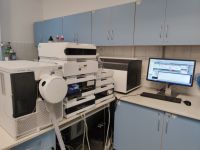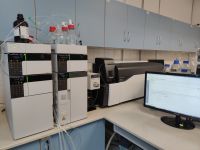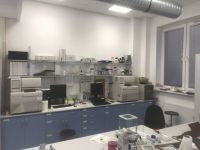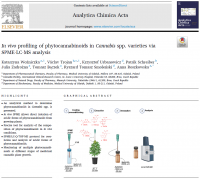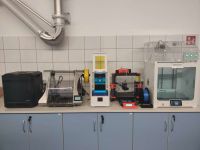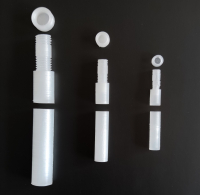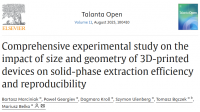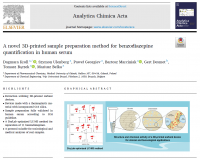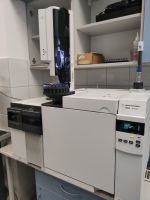Department of Pharmaceutical Chemistry
Faculty of Pharmacy
CORE FACILITY - PHARMACEUTICAL AND BIOMEDICAL ANALYSIS LABORATORY AT THE DEPARTMENT OF PHARMACEUTICAL CHEMISTRY
- Determination of endogenous substances
- In vivo solid-phase microextraction for phytocannabinoid analysis
- 3D printing
- Metabolic stability
- Labeling of organic substances
- Other research
- Detailed pricing
- Contact
Determination of endogenous substances
The bioanalytical section offers the following endogenous substances:
• amino acids by liquid chromatography
• biogenic amines, their precursors and metabolites using both liquid chromatography with mass detection (LC-MS, LC-MS / MS) and capillary electrophoresis (CE).
• steroid hormones and their metabolites using both liquid chromatography with mass detection (LC-MS, LC-MS / MS) and capillary electrophoresis (CE).
• analysis of organic compounds using capillary electrophoresis coupled with LIF detection.
Specification of bioanalytical analyzes performed with LC (pdf file, 707 kB)
Specification of bioanalytical analyzes performed with CE (pdf file, 679 kB)
In vivo solid-phase microextraction for phytocannabinoid analysis
In vivo profiling of phytocannabinoids in Cannabis spp. varieties via SPME-LC-MS analysis (pdf file, 2 MB)
K. Woźniczka, V. Trojan, K. Urbanowicz, P. Schreiber, J. Zadrożna, T. Bączek, R.T. Smoleński, A. Roszkowska, In vivo profiling of phytocannabinoids in Cannabis spp. varieties via SPME-LC-MS analysis, Analytica Chimica Acta, 1306 (2024) 342621.
In vivo solid-phase microextraction (in vivo SPME)
• Minimally invasive, non-exhaustive sample preparation technique that facilitates the direct isolation of low molecular weight compounds from biological matrices in living systems.
In vivo SPME coupled with LC-MS
• Precise and efficient real-time analysis — enables accurate monitoring of changes in phytocannabinoid content,
• you don’t need to collect plant material — extraction without interfering with plant development,
• continuous monitoring of phytocannabinoids content in the plant — allows changes in phytocannabinoid concentration to be tracked during plant growth,
• increased plant breeding efficiency — improves control of phytocannabinoid content, which supports better cultivation,
• direct and rapid analysis — allows immediate access to results without the need for long-lasting sample preparation,
• the ability to follow the metabolic pathways of phytocannabinoids in plants — allows a more accurate understanding of plant processes,
• extraction of free, biologically active phytocannabinoids fractions — allows to collect important data on the active forms of phytocannabinoids.
Direct contact regarding this project:
• Prof. Tomasz Bączek
tomasz.baczek@gumed.edu.pl
• Dr. Habil. Anna Roszkowska, Pharm.D.
anna.roszkowska@gumed.edu.pl
In cooperation with:
• Prof. Janusz Pawliszyn
Department of Chemistry, University of Waterloo, Canada
janusz@uwaterloo.ca
• MVDr. Ing. Václav Trojan, Ph.D.
Cannabis Facility, St. Anne’s University Hospital Brno, Czech Republic
vaclav.trojan@fnusa.cz
• M. Eng. Paweł Olszewski
Bioanalytical Laboratory — certificate of Good Laboratory Practice, Medical University of Gdańsk, Poland
biolab@gumed.edu.pl
3D printing
The idea behind the creation of the 3D printing studio is, among other things, to enable the production of technical solutions that are innovative or difficult to obtain commercially due to high cost or long waiting period. We offer substantive and advisory assistance at every stage of creation: from model design to final printing and post-processing. We also provide knowledge in the selection of the appropriate material for printing, prioritizing aspects indicated by the client: mechanical strength, chemical properties, biocompatibility, aesthetics, or others. The mission of the studio is to provide a wide range of services to members of the University community, with particular emphasis on its priority research areas.
One of our main goals is to facilitate access to additive technologies for employees, PhD students, and students, and to support them in designing and manufacturing three-dimensional objects with the help of experienced scientists.
Core Facility employs various 3D printing technologies:
• fused deposition modeling (FDM),
• technologies using light-cured resins (DLP oraz SLA),
• and soon also selective laser sintering.
We provide a wide range of different thermoplastic materials, as well as the equipment and knowledge to produce materials to special order.
The laboratory is equipped with the following elements:
• computers with access to specialist CAD (computer-aided design) software, enabling digital design of three-dimensional models tailored to individual needs,
• numerous 3D printers operating in various technologies and allowing for the quick, precise and repeatable production of designed objects,
• equipment for the comprehensive production of thermoplastic materials: a granulate dryer, a shredder and a single-screw extruder,
• tools that facilitate work with 3D printing, including those for post-processing prints made with various technologies,
• substantive and organizational support from experienced scientists working in this field.
Organizational support is crucial to enable the continuity of the lab’s work, ensure the safety of its users, and monitor its functioning. From the substantive side, the lab coordinator provides expertise in the selection of materials, maintains the functionality of devices, and supports the computer design process. The unit also serves didactic purposes, promoting the scientific activity of the university, or carrying out commercial orders received from external entities.
The 3D printing laboratory provides the following services:
• production of sorbents with personalized shapes and properties from thermoplastic materials and light-curable resins,
• production of thermoplastic materials on request,
• production of light-cured resins on request,
• production of laboratory equipment and various elements supporting laboratory work,
• assistance in designing and digital processing of three-dimensional models,
• conversion of files from various medical imaging techniques into stl files and subsequent printing,
• substantive assistance in operating 3D printers,
• expertise in the feasibility of three-dimensional projects.
The studio was established as part of the Excellence Initiative – Research University program.
Interesting didactic and didactic-scientific projects in which we participated:
• converting images from computer tomography of the urethra into three-dimensional prints supporting the course of surgical operations and the education of medical students,
• a program for visualizing the action of drugs at the molecular level – an educational and didactic project using 3D printing, involving creating models of interactions between the GABA receptor and drug molecules as part of the Innovators – 3D printing is the technology of the future project by Zortrax,
• converting three-dimensional ultrasound models into prints presenting the actual size of embryos at a given stage of fetal development, used for classes with medical students.
Our recent scientific publications covering the use of 3D printing technology:
Comprehensive experimental study on the impact of size and geometry of 3D-printed devices on solid-phase extraction efficiency and reproducibility (pdf file, 2 MB)
Marciniak, B., Georgiev, P., Kroll, D., Ulenberg, S., Bączek, T., & Belka, M., Comprehensive experimental study on the impact of size and geometry of 3D-printed devices on solid-phase extraction efficiency and reproducibility, Talanta Open, 11 (2025) 100410.
A novel 3D-printed sample preparation method for benzodiazepine quantification in human serum (pdf file, 3 MB)
Kroll, D., Ulenberg, S., Georgiev, P., Marciniak, B., Desmet, G., Bączek, T., & Belka, M., A novel 3D-printed sample preparation method for benzodiazepine quantification in human serum, Analytica Chimica Acta, 1337 (2025) 343552.
Articles involving 3D printing (pdf file, 134 kB)
Metabolic stability
The team of the Department of Pharmaceutical Chemistry of the MUG offers metabolic stability tests of drug candidates using the in vitro method, using the microsomal subcellular fraction. In a typical assay, microsomes obtained from human liver play the role of a biotransformation catalyst. The potential drug to be tested is incubated under strictly controlled conditions in the presence of the enzyme preparation and appropriate cofactors. Immediately after the start of incubation and at the defined measuring points (maximum incubation time is 2 hours), a sample is taken and then analyzed using the LC-MS technique. The metabolic half-life is determined on the basis of the obtained chromatograms.
Addressees of the offer
• Research teams dealing with the synthesis of new substances with potential application in medicine
• Innovative pharmaceutical companies
The service includes
• Selection of enzymatic incubation parameters
• Performing a control to determine the chemical stability under incubation conditions
• Development of the methodology of determination of the submitted compounds using the LC-MS technique
• Determination of the metabolic half-life
What are the metabolic stability tests for?
• They allow to determine the behavior of a potential drug against the human xenobiotic metabolizing system
• The stability of the candidate drug is a favorable feature due to its interaction with the molecular target
• Metabolic stability is one of the key factors influencing the pharmacokinetics of a drug
• Metabolites formed as a result of biotransformation may have an influence on the therapeutic effect as well as possible side effects
What are the possibilities of extending the proposed offer
The scheme presented above, including the determination of the metabolic half-life, may be supplemented with additional tests, including:
• Determination of cytochrome P-450 isoenzymes responsible for biotransformation
• Determining the possibility of the formation of reactive metabolites that interact with cellular nucleophiles
• Development of a model of the relationship between the chemical structure and metabolic stability within a given series of compounds
Metabolic stability articles (pdf file, 200 kB)
Labeling of organic substances
As part of the analysis of other organic substances, the following tests are performed:
• mass measurement using the ESI technique
• substance identification by “soft” and “hard” fragmentation
• analysis of volatile substances by gas chromatography with mass detection (GC-MS)
• analysis of organic compounds using capillary electrophoresis coupled with LIF detection.
Other Research
Other research experience includes:
• optimization of the conditions for the separation of analyte mixtures, including the selection of parameters for the preparation of the sample for analysis (extraction), as well as chromatographic and electrophoretic conditions (DryLab, chemometric optimization),
• validation of analytical methods and statistical and chemometric processing of results,
• study of the relationship between the structure and activity (QSAR), chromatographic retention (QSRR) and metabolic stability (QSMSR) of a given series of chemical compounds using chemometric techniques and specialized software: ACD, Dragon, HyperChem, Gaussian, SIMCA
• pharmacokinetic studies in the determination of drugs and their metabolites,
• stability and stability testing of pharmaceutical preparations,
• ELISA tests,
• study of bioavailability and bioequivalence of pharmaceutical preparations.
Detailed pricing for MUG
Detailed pricing for MUG
Contact
Dagmara Kroll
Department of Pharmaceutical Chemistry
Medical University of Gdańsk
al. Gen. J. Hallera 107
80-416 Gdańsk
+48 603 609 180
dagmara.kroll@gumed.edu.pl
